Feb 13, 2016 by TeeGee
We’re an interesting case. Even though I wish we weren’t.
If you’re not familiar with our work, three and a half years ago we’ve released Cinders. A fairytale visual novel, which became quite successful for such a niche genre, earning over $200k (still growing thanks to the Steam long tail).
Just a few days ago, we’ve launched a similar narrative game, Solstice.
I like experiments, so we went the same route as with Cinders: direct-only at first, with Steam launch only after some time has passed, allowing me to compare launch day data to see what exactly has changed in these three years.
So for all those indies wishing it would be possible to do A/B testing of the same game released in different times, we’re as close as it gets.
Spoiler alert: the results are not very optimistic.
Website Traffic:
Here’ the big one. This is our website traffic on the day of Cinders release:
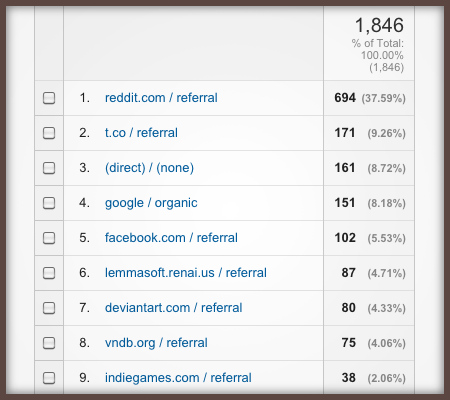
And the same thing for Solstice:
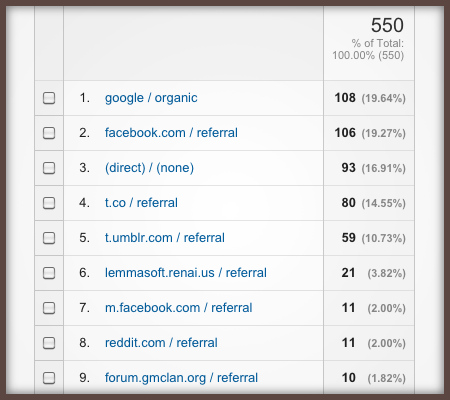
There’s a noticeable difference, but both numbers are nothing special and come mostly from social networks — about what you’d expect from a relatively unknown indie game’s soft launch.
But consider this: when Cinders came out, we were a new indie studio that just released its first title. No track record to speak of, no significant social medial following, no established fan base.
Solstice launch was by a different MoaCube. One that already released a successful and well-received game, made proper press contacts and garnered some following. And yet, despite us having three times the amount of social network followers, the traffic we generated was over three times smaller.
How come? Well, I’m no expert on social networks, but I have some experience:
Reddit used to be a great way for small indies to tell the world about their game, but anti self-promotion rules cut it short. We did get some attention on niche subreddits like r/visualnovels and r/gaymers (our game has a gay protagonist) a few days after the launch, but it’s a small thing.
Facebook, well, if you’ve been using it, you already know it sucks. Unpaid fanpage posts hardly show to anyone, and paid ones are pretty ineffective. We’ve actually got some traction on our announcement, but it was mostly my real life friends’ stream of congratulations (thanks, guys!).
Twitter is the biggest disappointment. In Cinders’ times, I’ve had less than 1k followers, mostly other indies. Today the number is 2.6k and includes actual players, the press, and a few internet personalities. My announcement tweet did pretty well with over 20k organic impressions but the result is still only half the visits of Cinders launch.
Interestingly enough, despite the much lower traffic, initial sales have been comparable to Cinders, which I find quite encouraging. I think that’s where having an actual fan base that waits for your game truly shines. Still, it’s going down fast, while Cinders managed to keep high sales for several days due to a steady traffic influx and press coverage.
Speaking of which…
Press Coverage
Oh, this is going to be a short one. Here’s a compilation of all the articles that appeared on Solstice launch day:

Yup…
And again, before you go “Well, yeah, it’s a super-niche game after all”, remember that so was Cinders and it actually got covered pretty well, giving it some initial traction and legitimizing its existence.
You know what else got some nice and enthusiastic coverage? Solstice, when we first announced it. The press quotes on the game’s site come from various previews and “games to look for” lists, as there were quite a few of those. Same outlets didn’t even post a news about the launch, despite us reaching to most of them before the release.
I’m not that surprised, to be honest. Video game journalism is in a difficult spot right now, fighting an uphill battle against social media, user reviews, and the general overflow of new titles. Some cool sites we relied on simply died out or are in zombie mode, and the largest ones stopped covering new indie game launches, officially or not.
Additional depressing food for thought: Cinders got covered mostly by female journalist, as they seemed much more open to playing something different. When I updated my press list for Solstice launch, I realized that exactly 0% of my female journo contacts have remained in the industry. (And before you ask — the dudes are still there). Ouch!
Conclusion:
I don’t like or want to toot the doom’n’gloom horn and announce the coming of indie apocalypse, like many of my peers did in recent months. Especially not so soon after a release. This is not a postmortem nor failure study.
I’m in indie games for 10 years now, and I know well that the market is in constant motion. It’s natural, and you simply have to learn to adapt. I did this experiment to check what exactly has changed in in those last few years, and it appears that — well — quite a lot!
Mostly, as I already suspected analyzing our day-to-day numbers, it seems that your game doesn’t exists unless it’s on Steam.

Guess which year it came out on Steam
I admit I don’t like it. If a somewhat established indie, with a clearly defined audience and some following, can’t generate enough traffic to live from direct sales alone, this means we’re no longer independent developers, we’re Steam developers.
Steam’s discoverability algorithms are quite ruthless and prone to butterfly effect, and the system’s so massive that it can’t be affected externally (at least not on indie scale). To maximize your chances, you have to carefully target your games for the specific Steam trends and audience.
I worked on casual games for three years, and observed the same thing happen with the rise of the BigFish Games portal. As it converted more and more players to its customers, direct sales died out and it became all about hitting that BigFish’s Top-10 bracket. PC casual evolved from coming up with a cool-but-simple mechanic to making one of those Hidden Object Puzzle Adventures that sell on BFG. It was my payday loans direct lenders why my last employer Codeminion decided to disband despite financial success.
I don’t think things are as bad with Steam, as it’s much more cleverly ran, and its audience’s tastes are wider. But it’s time to accept that their monopoly is almost absolute in the world of indie PC gaming, and it affects us creatively too. I for one know that you won’t see another visual novel from us soon. And while I still wanted to take a break due to genre fatigue, I’d prefer it to be at my own terms.
I’ll definitely write more once Solstice arrives on our friendly neighborhood monopolist, and hopefully it’ll be more uplifting. We aimed for an April release, but may push it sooner, depending on how things go.
If you want to know how we’re doing in the mean time, consider adding me on twitter.
EDIT: This article had more views in a few hours than our game during its entire launch day. 0_o
Sep 24, 2014 by TeeGee
So hey! The much rumored Steam overhaul is here, promising to bring all the changes you’ve ever been hoping for!
It’s still too soon to judge how (and even if) it’s going to affect things in the long run, but I thought I’d share my early impressions, based on my own experience and conversations with other indie devs.
As a player:
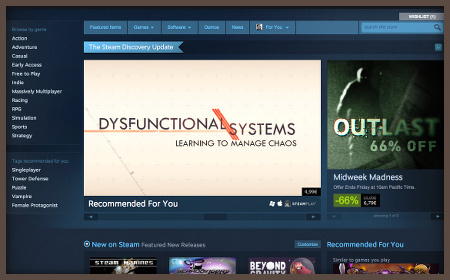
- Hot damn is it blue!
- The main capsule finally shows me something I haven’t seen a thousand times (and got already). Including some older and/or niche titles. Major improvement here!
- The Discoverability Queue is same old, though. We’ve spent good 15 minutes with Gracjana laughing at the suggestions she got. “Hey, have you played Countersrike? Nope, then maybe DotA2? Okay, what about DayZ, ever heard about this one?”
- Curators are cool. Already found a few with tastes similar to mine.
As a developer:

- Cinders sales and traffic went up almost thrice, and I’m hearing similar reports from other indies. It will undoubtedly calm down after the dust settles, but I’m guessing it’s still gonna settle on something higher than before. Mind it’s for a title way into its long tail.
- As a niche developer, I like that they put more weight on user reviews. Games like ours usually have a small but very supportive audience, which results in a higher than average reviews-to-sales ratio. The new system promotes fan favorites, giving them some welcome extra visibility.
- Same thing applies to tags and recommendations. According the the new analytics tool, we’re getting quite a lot of traffic that we wouldn’t get in the old system. That traffic also seems to have a pretty high conversion rate due to better targeting.
- Speaking of the new analytics tool. It’s very cool! Allows you to see where exactly your store traffic is coming from. Invaluable data given how complex and vast the Steam ecosystem is.
- Curators are yet another group of people indie devs will have to kiss up to, but such is life. They’re still vastly better than Valve deciding who’s allowed to see our stuff. That said, so far the curator traffic is negligible.
- Soo… Are we supposed to email curators? Hand them keys? Is it moral and doesn’t it defeat the whole purpose? I’m still unsure what the code of conduct’s going to be here.
- It seems it’s going to be easier to maintain a reasonable long tail on Steam now, as interesting games are at a lower risk of getting completely buried than before.
- I’d say launches are going to be harder, though, and require a bigger and more focused marketing push (or a considerable ad budget) to get things rolling. Most new releases will get even less visibility than in the old system. Reaching that critical mass of features and recommendations is going to be crucial.
- I think the next step is the official shutdown of Greenlight and replacing it with an open AppStore-like model. Expect it soon.
Overall, despite my general Steam-skepticism, I’m pretty optimistic towards the new storefront. Early signs are promising: most of the shovelware should get buried fast, hits will remain hits, and underdog fan-favorites are given a second chance. It’s all good and I don’t see any immediate drawbacks or risks.
I’ll try to post another short article after around a month of using the new system, to see how it fares in the longer run. Meanwhile, you can follow me on twitter as I’m probably not gonna shut up about it for quite a while. 😉
Mar 28, 2014 by TeeGee
I have to admit that up until GTA V, I never liked Grand Theft Auto series.
I guess I just didn’t see the appeal of playing awful people doing awful things, and the dissonance between the destructive sandbox and strictly scripted story missions annoyed me to no end. I still played the series out of professional curiosity, hoping for something closer to my beloved Red Dead Redemption, only to end up being disappointed again and again.
And then something happened when I was checking out GTA V. Between all the car chases, shootouts, and wisecracking one-liners, I’ve decided to take a break and call my (in-game) wife. I knew she wouldn’t pick up, that I’d just end up hearing her voicemail message, but I did it anyway. Why?
De-gamification:

Former GTAs did that thing, where you had to keep interacting with your girlfriend and friends to gain some bonuses. So maybe I did it for gameplay benefits? An achievement at the least?
Nope. It had no extrinsic reward attached. When you think about it, that’s true for most actions in GTA V.
It’s pretty shocking to see a AAA sandbox do away with all the reward loops the genre is known for. No collecting, no building, no crafting, no taking control over the map. According to modern game design knowledge, it should be a recipe for disaster. In reality — it’s liberating!
I remember getting so absorbed by the collectible icons on the mini-map in Far Cry 3, that I missed the fact I ventured into a giant ship scrapyard. All the level design work went to waste, because I was too focused on finding totem #76 to get my 500xp reward.
No such thing happens in GTA V. You can go on a walk across the beach, take a bike ride to the countryside, or admire graffiti without worrying about hidden money stashes, dead drops, or whatever else the designers came up with. If you do something, it’s because you yourself want to. Not because there’s some carrot attached to the end of the stick.
Same thing applies to interactions with NPCs. You can call your buddy and hit the town together, but it won’t unlock a better weapon nor increase their loyalty variable. You simply get to hang around and listen to what they have to say about the latest events. Or you may just get wasted and go to the movies.
It makes the game’s world feel like — well — a world, instead of a glorified chessboard where every action is a veiled strategic decision.
Too big to handle:
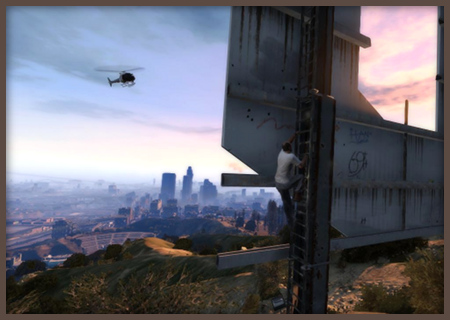
And it’s a huge world, too. I don’t think it’s possible to see everything in GTA V. Even if you are very dedicated.
You could see it as a wasted effort. After all, would it hurt the game if there were two less radio stations to listen to? Would the sales drop if the in-game internet and facebook spoof had half as much content and depth? Probably not.
But in this case the trick doesn’t lie in balancing the amount of content so that players can see the most of it. It’s in making sure they won’t. If the game can create virtual reality that’s just too big to explore and deconstruct, every choice suddenly becomes more meaningful.
How so? Let’s take a good story-heavy RPG as an example — like Mass Effect. Its important component is talking to various NPCs and party members, which unfolds their backstories and creates a nice sense of depth to the world. To a point…
After a while, you begin to notice the underlying structure. You just have to run around Normandy after every major mission to see all crew dialogue the game has to offer and unlock every loyalty mission or romance. It’s still enjoyable, but hardly like living in another world — it’s back to being just a game. With a clear set of rules.
I approached GTA V with the same mindset of trying to see everything, but it’s simply impossible. Even the LifeInvader (in-game Facebook parody) itself is too big to handle. Three protagonists, each with their own set of friends posting hundreds of messages all the time. You’d go crazy trying to get through it all. I gave up quickly.
However, when Michael’s family leaves him (umm, spoiler alert?), I’ve found myself checking their LifeInvader accounts to see what’s going on with them. Let me reiterate: I stalked my wife and kids on Facebook. In a video game.
If you simply can’t do everything, then what you actually choose to do becomes meaningful.
We used the same trick in Cinders by having so many choice points that the player had to stop trying to figure out their structure and give in to role-playing. GTA V uses its crazy budget to crank that up to eleven in every aspect of the game, obscuring the underlying mechanics with sheer amount of content.
And speaking about hiding the structure…
Directed sandbox:
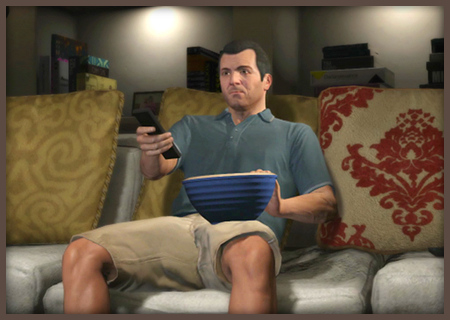
Complete freedom has its charm, but not when you’re trying to tell a story.
If you had asked me about my Skyrim character, I couldn’t tell you much. He was a saint solving problems of everyone who asked for help, but — umm — he also kind of lead the guild of evil assassins. He also enjoyed killing stuff in caves… And crafting armor. Oh, and that one time, he put a bucket on a shopkeeper’s head, because he saw that on YouTube. Good times.
That’s a common problem with sandbox games. Players see right through them and treat them as theme parks — taking every ride possible, and quickly forgetting about their initial goal.
GTA V solves that problem by using various tricks to make it all seem like a directed experience, despite the player still being able to do anything they want. One brilliant inclusion are the short scenes that play when you switch to another character.
Let’s say you zoom to Michael and find him trying to watch TV, while his wife argues with his daughter again. Finally, he can’t take it anymore and leaves. This little scene gives context to anything you decide to do afterwards. If you go and rob a liquor store, it’s not another ride at the theme park anymore. It’s a frustrated, aging thief unable to cope with normal life, committing a petty crime to feel that thrill again. In short — it’s a story.
Having three playable characters is another brilliant move. If you’re in a mood for some rampage, you can switch to Trevor who’s likely to be already in trouble. If you want to try the stripper mini-game (which is wrong on so many levels…), you can do it with Franklin and reinforce the point that the life of crime has made him lonely. You can do any crazy gamey thing and still have Michael behave like someone who’s genuinely trying to fix his life. Unlike my Skyrim character, you are allowed to stay in role and still get to enjoy the sandbox.
But let’s get back to my reasons for calling my wife…
I thought that at this point in the storyline, when things take all the wrong turns, Michael would like to hear her voice. Even if it was just a voicemail greeting. I thought that would be an important point in his character development if I were in charge of the story.
And the funny thing is: at that moment, I was!
GTA V is still a troubled game. It constantly struggles to find its identity, unsure whether it should be The Sopranos or South Park. The overarching storyline seems fractured and makes little sense, and it’s all just… unpleasant or downright offensive.
However, it managed to make me feel like a part of an actual virtual world, and gave me tools to tell my own story within the framework provided by the designers. All without “breaking” the game. I can’t help but call it a milestone in video game storytelling. Sure, it’s still an adolescent power fantasy, but it makes me excited for what other developers may do in the future.
Because imagine a video game equivalent of an HBO show. Only instead of merely watching, you get to live through it…
Thanks to Auriea of Tale of Tales for inspiring me to write this article. And if you want to say hello or see what we’re up to these days — check my twitter.
Feb 7, 2014 by TeeGee
In my last blog post, I talked about how good gameplay balance goes beyond the spreadsheets and relies on understanding how players perceive and evaluate their choices.
But let’s be honest — at the end of the day, you still have to put some numbers in for the game to work. And if you botch it badly, no amount of clever mind games is going to help.
Here are a few tricks I’ve picked across my career as a game designer that should let you deal with immortal romance more efficiently, without going insane in the process.
Keep it simple:
Yeah. I know. Every article on every design-related subject starts with this. It’s because it’s true.
Human minds don’t comprehend large numbers, probabilities, complex formulas, and their intertwining relationships very well. Remember AD&D, with its 18/00 strength, THAC0, and negative armor class? There’s a reason why it got simplified a lot in later editions. Overly complex and several-step computations are not intuitive and hurt the ability to make informed decisions on the value of each action, while adding nothing to the strategic depth of the game.

Yeah, right.
It’s not limited to players, too. You, the designer, will have a lot more trouble keeping a unnecessarily complex system in balance. So try to make your mechanics as close to what-you-see-is-what-you-get as possible.
Use a consistent scale:
My Druid in Diablo 2 dealt around 20k damage per attack, had 6k to-hit rating, and only 2k health. Does that mean he was a glass cannon, dying from a single hit, but dishing out crazy amounts of damage, assuming he could hit anything with his low to-hit?
Nope. He was actually a tank-type character. Monsters could have well over 100k health points, but dished out damage in low hundreds, and 6k to-hit was more than enough to connect with 95% of attacks. But how would you know that when each of these stats seems to follow a completely different, arbitrary scale?
You can probably see where this is going…
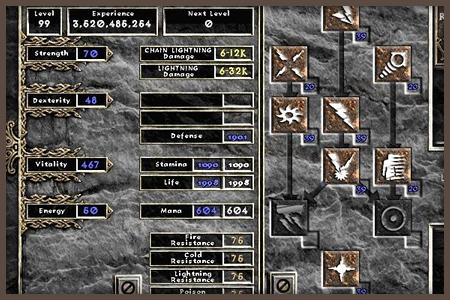
Consistency is for the weak!
Using a consistent scale makes things much easier to comprehend for both you and the player.
In Bonfire, I’ve made a conscious effort to keep everything between 1 and 100, with 20 being the base value for all actions. This makes its balance much more transparent. If something is at 75, it universally means it’s high. If a skill raises a stat by 20, it’s roughly equivalent in value to an attack that does 20 damage. It also allows me to use similar formulas for most computations, from how much damage an attack deals, to how fast a character gets their turn.
Boil things down:
I’ve found that it really helps the balancing process if I boil things down to single numerical values. From abilities’ power to each level’s difficulty, it’s just much faster to operate on easily comparable variables.
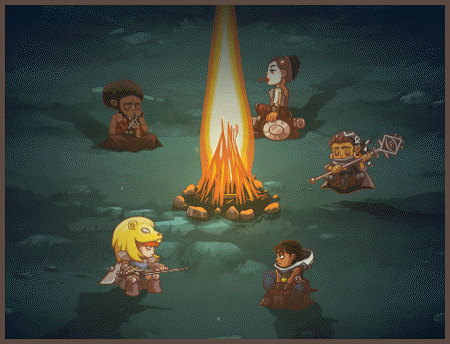
Shameless Bonfire plug.
For instance: all abilities and attacks in Bonfire have a magnitude value assigned to them. If an attack has a magnitude of 2.0, it will always deal exactly twice as much damage as a 1.0 strike. This way, even if underlying formulas change later, relationships between various items are kept intact. If an action was designed to be twice as powerful as another, it will stay that way even if I mess around with how their effects are calculated.
Same thing applies to difficulty levels, despite them being much harder to clearly define. It allows me to see the balance between various aspects of my game at a glance, which speeds ups the development significantly.
Keep global modifiers for everything:
Like many game designers, I used to be into modding before going professional. When doing a small re-balancing patch for Oblivion, I wanted to solve the problem of enemies and the player character requiring way too many hits to kill. Fortunately, I didn’t have to tweak damage values for each and every weapon, as the game had a definable global multiplier for attack power. I could test various possibilities within minutes and see what fits the dynamic I had in mind.
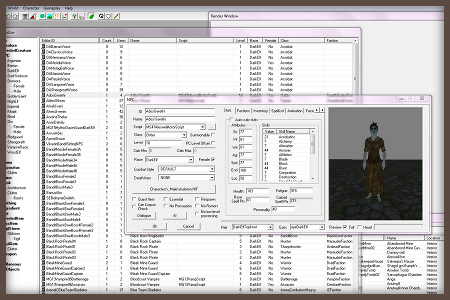
Officially more fun than the game itself.
Thanks to this lesson, I always abstract global multipliers for pretty much every single aspect of my own games’ balance.
Because, here’s the thing — no matter how good you are, your balance will require several iterations before you get it right. If you can quickly check how your game would play if all characters moved twice as fast or died from just a single hit, you’ll arrive at something fun and playable much sooner.
Avoid using arbitrary resources:
Is 100 mana high or low? Is Fireball balanced if it costs twice as much as the half as powerful Firebolt? Probably. But what if mana actually regenerates quickly? Or if a high-level character can easily have more than 1000 points in their blue bar? Does the higher price still matter in that case? What if the player stacked up on potions?
This is a problem with using arbitrary resources that have no intuitively understandable value — they are very hard to get right, as they make no sense outside of the ruleset of the game.
A move to natural resources improves things a lot. Let’s consider changes made from Demon’s Souls to Dark Souls. Demon’s Souls used the classic mana system. It was pretty tight, but had its problems. For example: some spells were clearly designed for a single use, with their mana cost close to the possible maximum. However, players could grind for magic-restoring herbs to break the system and make large mana costs of those super powerful spells have little consequence.
Dark Souls fixed that by simply having a pre-defined amount of uses for each spell. A very natural resource that’s immediately understandable and easy to evaluate. If the weaker Firebolt has thrice the uses of Fireball, it leaves me with an interesting choice to make. Should I take the more powerful spell for use in critical situations or go for the flexibility of being able to use ranged attacks more often. It’s also easier to balance the cost of each spell, as it’s a single non-arbitrary value that can’t be broken by other gameplay aspects feeding back into the system.
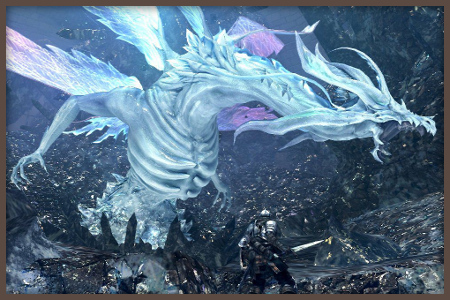
Dat design!
Time is another good natural resource to use, and it doesn’t have to involve cooldowns. Dragon’s Dogma balances its spells not only by how much stamina they cost, but also by how long it takes to cast them. A weaker spell may be simply more practical, which is something of clear value to the player. It also adds an interesting gameplay dynamic where you try to find a good position and moment to evoke some game-changing magic.
Of course, no set of tips will replace solid math, playtesting, and the right amount of iterations. They should, however, speed up the process, and make it easier to communicate your game’s balance to the players in a way that allows them to make informed decisions without relying on a FAQ.
If you have any tricks of your own, feel free to share them in the comments.
Consider following me on twitter, if you found the article helpful or just want to chat :).
Jan 16, 2014 by TeeGee
When you only start learning how to draw, you doodle. It’s fun and it sometimes even looks okay. Then you begin to grasp the rules of anatomy and composition, and everything changes. Now you know how to visualise something properly. The true mastery, however, starts when you learn how to get away from that “correctness”. Break conventions to focus on what actually matters. Basically, get back to doodling.
In my experience, same applies to gameplay balance. I still remember how I worked on my earliest games. Added whatever seemed cool, balanced it with semi-random numbers, then tweaked things during playtesting. When I began to see game design as a profession and started educating myself, I’ve learned the power of careful planning and making sure the math is sound. But the better I get, the more I realize that numbers are just a basis and good gameplay balance comes from aspects that are impossible to capture in a spreadsheet.
Before I get to examples, a minor disclaimer. Balance is a broad term, so let me clarify that I’m talking about gameplay/strategic balance. Or even clearer: making sure that if two options are available to the player, they are both just as viable.
Balance by unique purpose
This one’s pretty obvious, but needs to be mentioned. The simplest way to ensure that all options are appealing to the player, is to give each a unique purpose.
Let’s consider Diablo. It has several missile-type spells: Firebolt, Fireball, Lightning. Each deals ranged damage to enemies, with minor differences in area of effect, mana cost, and power. It’s not a very interesting situation strategically, as one of those simply has to be the best option. Unless you’re fighting fire immune enemies, there’s little reason to use anything other than Fireball.
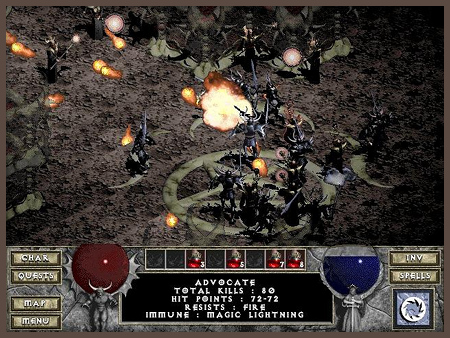
It’s not just the graphics that aged.
But what happens if we give each spell a unique effect and purpose? Let’s say Firebolt sets enemies on fire for a duration, Fireball is powerful but can’t be used at point blank, and Lightning stuns monsters for a few seconds. Way more interesting. Even if numerical balance if off and Lightning costs too much mana, it’s still useful when you want to get away from enemies (possibly to set them up for another Fireball).
A good positive example would be weapon design in modern shooters. Three assault rifles with different stats would be boring, so you usually get a generalist rifle, a shotgun devastating at close range but useless at a distance, and a sniper weapon with the opposite qualities. Regardless of their exact stats, all weapons are going to be useful in specific conditions.
Balance by synergy
The logical next step from giving every option a unique purpose, is to make them work best in tandem. I discern two types of synergies: soft and hard.
Soft synergies emerge naturally from game mechanics. The tried-and-tested RPG cliche of tank + healer is such synergy. It’s never said that you need to have at least one knight and one priest in your party. They just benefit greatly from each other’s presence. Even if designers screwed up, and the knight has more interesting skills and gear selection, you’ll still want to use the priest to get as much as you can from your powerhouse character.
Hard synergies are formed by specific gameplay mechanics designed to make two options compliment each other. Dragon Age 2 works like that. It has two melee classes: warrior and rogue. To make sure that you’ll want to keep both in your party, there are several powerful skills that the rogue can use on “staggered” enemies. The caveat? Only warrior can apply stagger.
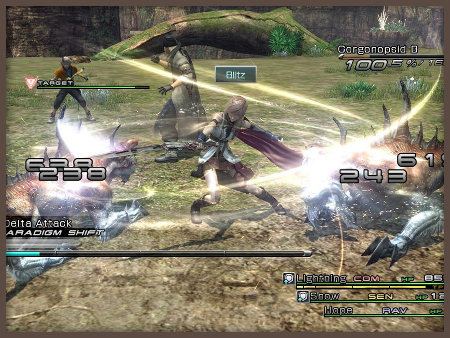
So there’s something worthy in this game after all.
Similar thing happens in Final Fantasy XIII combat system. It features a bar that fills with each consecutive hit, increasing damage dealt. Mages are good at raising this bar, warriors can prevent it from falling down. So you need both, regardless of how well their skills are balanced.
Balance by cool factor
Something designers often forget, but has a great impact on the players. I can point to my first commercial game, Magi, as a perpetuator. It features two basic attack spells: Magic Missile is used for quick and steady DPS, Fireball is slower and overall weaker, but breaks shields. Both have their unique purpose. But I’ve noticed that many players stop using Magic Missile once they unlock Fireball. Why? Because it’s a friggin’ ball of fire that goes boom! Likewise, very few players ever used curse spells, despite me making them somewhat overpowered in the end. It’s just that stat decrease isn’t as awesome as blasting away with missiles.
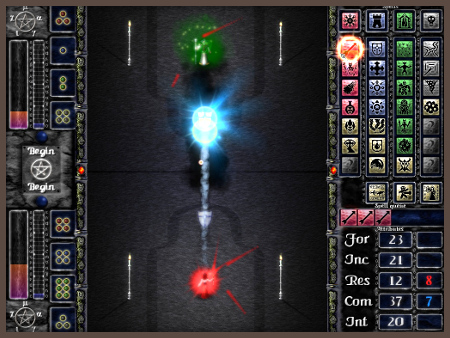
Not cool enough!
Players usually don’t know the underlying mechanics or how the numbers interact with each other. But they do know that huge explosions are cool, and it affects their tactical judgement. After learning this lesson, I try to make sure that all options are fun to use and have clearly visible effects.
For instance: in ArcMagi (the planned sequel) we replaced a curse that lowered opponent’s defenses with one that makes them spontaneously combust whenever they are hit. The effect is the same: increase of DPS from your other spells. But hell if it isn’t ten times as cool!
Balance by convenience
In Starcraft, a Zerg Queen can destroy any ground unit with her Spawn Broodlings ability, creating two melee fighters as a bonus. On the other hand, a Guardian can attack ground targets for 20 damage a shot. And yet, these two units are balanced. Queen has you manually pick her ability, check if you have enough mana, then click the desired victim. Meanwhile, Guardian just attacks on its own and takes less effort to micro-manage. This is balance by convenience.
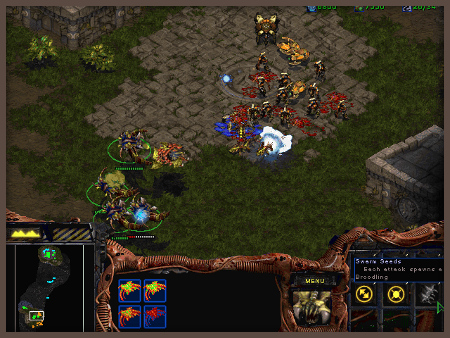
Still holds up in so many ways.
Fighting games are another great example. A complex 10-hit combo or a special may deal more damage, but in the heat of actual battle you’ll often rely on much weaker but simpler to execute techniques. Or you may simply be too lazy to spend hours practicing those 10-hit finger twisters when there are other options available.
Because that’s the thing — we, humans, are lazy. We tend to chose convenient solutions, even if they aren’t exactly optimal. Manual targeting, difficult to master input, or even something as simple as walking slower when you wield a big weapon, can be seen as a huge hindrance and used to balance options beyond their numerical values. The nice bonus of balance by convenience is that it rewards skilled players who are willing to deal with all the extra hassle to master the game.
Balance by meta changes
This is a very powerful technique that’s especially appealing to small indie developers, who have absolute control over every aspect of their game. Sometimes the best way to make an option viable is to alter the environment it’s in.
Consider a theoretical cover-based shooter with a shotgun weapon that’s heavily underused, despite killing everything in one shot up close. The thing is, this is a cover-based shooter. Enemies don’t come up close. They keep their distance and hide, occasionally firing a few shots before getting back into cover. Under these circumstances, an accurate long range weapon that can pop some heads is a preferred choice. No matter how crazy the shotgun’s stats are.
However, if you were to add melee enemies, who charge or ambush the player, and if those enemies would be heavily armored– Man, shotgun sure starts looking like something worth carrying!
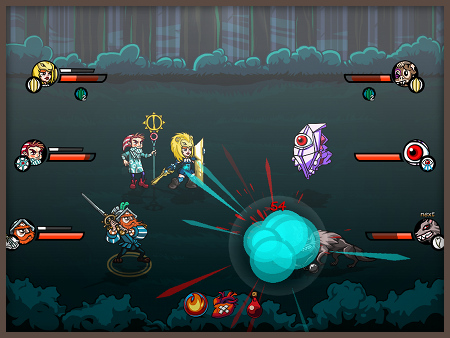
The spell-eating golem took many heroes’ lives.
A real-life example would be an issue I had with my Bonfire. I’ve found out that parties based on buff/debuff stacking were too powerful. I could nerf buffs, but that would make classes using them quite unattractive. Besides, they were only overpowered in a particular combination. In the end, I added several enemies that feed on buffs or can turn them against the party. You can still use the same strategy and have fun with it, but now it comes with the risk of running into something that’s going to be very hard to kill without a drastic change in approach. Not only it solved the issue, but made the game more tactically engaging.
Balance by lack of balance
Yes, lack of balance can be a conscious design choice as well, and it often works well.
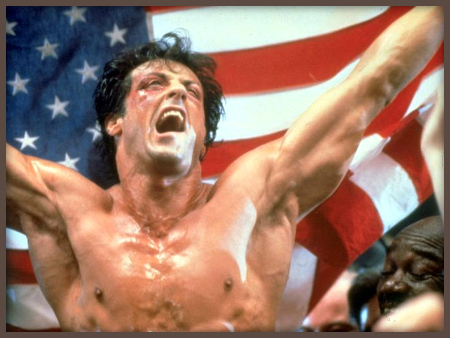
Yo, Adrian!
Arcade fighting games often include characters that are weird, tricky or simply less optimal to play and stand little chance in any serious tournaments (but if someone does win using them…). Likewise, there are characters who are easy to win with, even for beginners. In a way, this works as a hidden selectable difficulty level. Some players like to battle against unfavorable odds, others prefer simpler way to victory.
As long as your game has enough viable options to make it varied, don’t feel bad that there’s some underdog choice that only a select few pick (and probably enjoy the game more for it). Haven’t you seen Rocky? People love the underdog!
Of course, if numerical balance is way off, even the best psychological tricks won’t work. There are also the hardcore players who crunch numbers as well as any seasoned designer, if not better, and you need those. That’s why next week (or so…) I’m planning to publish the second part of this article with tips on how to handle the numbers game without going crazy.
EDIT: The next part is up.
If you found this essay helpful, please consider following me on twitter.



















